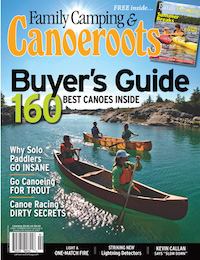It started to rain the minute we pulled into our campsite at Pacific Rim National Park on Vancouver Island. With nerves frayed from the four-hour drive from the ferry dock in Nanaimo with two kids in tow who needed regular potty breaks, my wife Sheila and I didn’t waste words as we divvied up camp chores.
In fading light and intensifying rain, Sheila unfolded the brand-new canopy that would cover the picnic table so we could start dinner. In seconds, the instruction sheet became a wadded mess as useless as wet toilet paper. The pick-up-sticks cluster of poles lay haphazardly on the ground, while eight-year-old Cameron and six-year-old Maddie came up with novel ways to express their feelings about being hungry and wet.
As any parent in the outdoors should know, you need to pick your battles. Though the plan had been to save money and engage the kids in the rewarding task of preparing campstove meals, Sheila and I tossed in the wet, sand-encrusted towel before we even started.
Off to Tofino we went, about 15 minutes by car. We pulled into Breakers Restaurant and ordered enormous burritos while tourists and locals—you could pick out the surfers because of their sunny complexions and matted hair—came and went.
Tofino has always had a mellow, hippie vibe which has set it apart from the rusty logging towns that dot the Vancouver Island landscape. Nearby Clayoquot Sound was the battleground of one of the fiercest wilderness preservation battles in British Columbia’s recent history of combative environmental activism. A street-grid of art galleries, funky cafés and tourist shops are packed with people from all over the world during July and August, with oceanfront cottages renting well into the four-figures per night. The harbour bustles with charter fishing boats, floatplanes, and whale watching vessels.
The following day, we cruised back into town and stopped at the funky Surf Sisters store where tanned, tattooed and pierced surf divas were booking 90-minute introductory lessons. We decided Cam and Maddie were too young for actual lessons this trip, but they immersed themselves in surf culture all the same by begging us to buy all the coolest surf brands.
My wife and I pulled on clammy wet neoprene suits, hoods, gloves, and booties. Next to us was a family of four from Calgary— two young teenage girls, plus a mom and dad—all with perfect white teeth. You just knew that they’d make it look easy. We convoyed down to Cox Bay under moody, misty morning skies.
From the start, our cheery, dreadlocked instructor was shout- ing orders on how to “pop up” from a prone position in order to stand on the 11-foot longboard and ride the wave.
I was still practicing those pop ups on the imaginary board that we had traced out in the wet sand when the instructor called to us to get our boards and start padding into the surf. Actually, the term “surf” was a misnomer. In summer, the fearsome North Pacific usually slumbers. Indeed, I’d seen bigger boat wake on Lake Okanagan than the swells lapping up on the beach. Would this be a proper test of my surfing soul?
One gentle swell after another—none was greater than two feet high—rolled under me and frothed while I paddled and popped so that I was standing tall—or at least kneeling tall. Getting to my feet proved impossible, but with very little effort I began to enjoy just bobbing up and down on the swells. All that soul stuff about the ocean being like amniotic fluid, well, I was buying into it. It was bliss.
Alas, the peaceful vibe was broken by our kids who started to heckle us from the beach. Cameron yelled, “Get on your feet, Dad, like those girls over there!” On the next wave over, the Calgary teens were, just as I surmised, naturals—riding the tanker boards through the froth like Kelly Slater and shrieking with delight.
IT’S A SOUL THING
We all spent hours on various floating toys—my kids opted for boogie boards on which they surfed without standing up; giggling and screaming on wave after unceasing wave. Though the kids didn’t take lessons on this trip, they showed that their natural agility and sense of balance let them take to surfing—in its various forms—much easier than adults do. Indeed, one of our neighbours at the campsite borrowed our board for his 10-year-old twins, one of whom hopped on board and was instantly getting consistent rides on the shore-break.
It’s important to note, though, that the real surfing takes place well offshore, where much larger waves curl and break. We watched the distant figures slashing their way down the faces of monster waves, but felt no less proud of our own surfing. Though some might call it glorified boogie boarding, real surfers will tell you, it’s a soul thing.
For six straight days after we arrived, the sun shone on our little crescent of the Pacific Rim. The instructions for the picnic table canopy dried, but we never did try to read them. Instead, we’d pilgrimage to nearby Long Beach, where men and women, boys and girls of all ages dragged huge foam-covered behemoth beginner boards across the sand toward the sea with religious determination.
We drove back home with Jack Johnson in the CD player, sand in our hair, sunburnt noses, and the Pacific surf ringing in our ears. Could the North Shore of Hawaii be next?
B.C. adventure writer Steven Threndyle has crossed off “Surfing in North Pacific, with family” from his life list.




